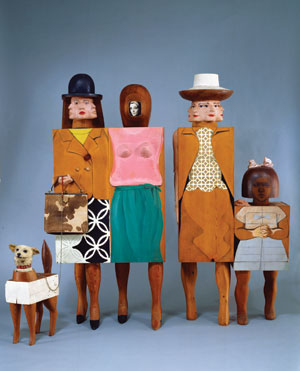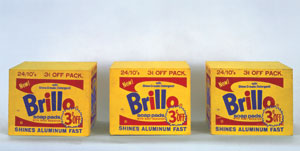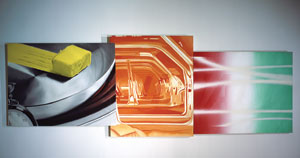
Marisol...Women and Dog...1964...Wood, plaster, synthetic polymer, taxidermed dog...head and miscellaneous items...Overall: 72 x 85 x 48 inches...Whitney Museum of American Art, New York...Purchase with funds from the...Friends of the Whitney Museum of American Art...64.17a-g...©Marisol/Licensed by VAGA, New York, N.Y. ...Photograph by Robert E. Mates
Shortly after "Extra-Ordinary: The Everyday Object in American Art" opened at the Austin Museum of Art (AMOA), I kept hearing about a taxidermic dog with wooden legs. Intrigue led to a personal visit simply to meet this creature, eyeball to glassy eyeball. Parisian-born Marisol Escobar’s life-sized Women and Dog is a row of carved, wooden effigies intended as self-portraits, accompanied by a severed dog’s head attached with a weathered red collar to its wooden body. The stage-like display contains all the ingredients imperative for a Jan Svankmajer scene of disturbance and surrealism. Multiple visages and the posed wooden legs make these ladies seem like a chorus line on the cusp of a dance step. Categorized as assemblage, Women and Dog takes visitors by surprise as they exit “Extraordinary Design,” a related exhibit of Austin industrial designers in the back of the museum.

Andy Warhol...1928-1987... Brillo Boxes...Synthetic polymer and silkscreen ink on wood...Each box : 13 x 16 x 11 1/2 inches...Whitney Museum of American Art...Gift of The American...Contemporary Art Foundation Inc., Leonard A. ...Lauder, President, 2002.269; 2002.270; 2002.271...©2007 Andy Warhol Foundation for the Visual Arts/...ARS, Photograph courtesy PaceWildenstein
Organized by the Whitney Museum of American Art, "Extra-Ordinary" allows
visitors to use their cell phones to access curatorial commentaries or
to leave personal observations. Met with a row of wooden Brillo boxes,
visitors are asked to leave a message either in support of or negating
the artistic significance of Andy Warhol’s 1964 pop culture icons. For
seasoned patrons, this feature with its unsophisticated defenses and
observations detracts from the museum experience. Still, the
educational element to this part of the exhibition must be factored
into the overall equation. If these sculptures continuously provoke
dialogue and critical analysis, then they merit a place in this Whitney
Museum collection.

Claes Oldenburg...Giant BLT (Bacon, Lettuce, and Tomato Sandwich)...1963...Vinyl, kapok, and wood painted with acrylic...32 x 39 x 29 inches...Whitney Museum of American Art, Gift of The...American Contemporary Art Foundation Inc.,...Leonard A. Lauder, President, 2002.255a-s...Photograph courtesy of PaceWildenstein
Well-documented and infamous objets d’art first seen in photographic
representation commonly grow to monumental proportions in the mind
before one sees the work itself. One employee at AMOA said she imagined
Man Ray’s New York 17 (1917/1966) to be as tall as the gallery ceiling,
almost 12 feet high. Surprisingly, the steely skyscraper sits only two
feet high. I myself have dreamt of the Giant BLT (Bacon, Lettuce and
Tomato Sandwich) (1963) by Claes Oldenburg. Having seen this comical
sculpture only on a postcard, I imagined it to inhabit an entire room.
The vinyl sandwich displayed alongside its 1963 French Fries and
Ketchup counterpart seemed just as delectable and malleable as I had
envisioned it, but a much smaller object in his oeuvre.
Peeling away a commonplace object’s skin in search of poetic
significance, "Extra-Ordinary" takes traditionally mundane and neglected
objects and spotlights their inherently unremarkable characteristics.
The quintessence of the works in "Extra-Ordinary" comes from scale and
their Argus-eyed artists. An utterly insignificant brown paper bag
becomes a stiff monument to all its measly, discarded predecessors when
it stands more than five feet tall. Artist Alex Hay captures every
stubborn crinkle, each shadow and detail, down to the green tree stamp
from an anonymous manufacturing plant. I wanted to ignore this
thankless object, but somehow it acquired a certain physical pathos.
Using epoxy, fiberglass and paper, Hay has made it impossible to ignore
this humble corner store container.

James Rosenquist...U-Haul-It...1967...Oil on canvas in three parts... 60 x 160 1/2 inches...Whitney Museum of American Art...Purchase with funds from Mr. and Mrs. ...Lester Avnet, 68.38a-c...© James Rosenquist...Licensed by VAGA, New York...Photograph by Robert E. Mates
Similarly, James Rosenquist’s U-haul-It (1967) shows how repetition and
billboard-influenced stylization can transform a prosaic vehicle into a
hot, nectarine-tinged object of desire. His oil on canvas pulls
background utilitarian objects to the forefront by subtly overlaying
logos, exaggerating truck light fixtures and throwing a colorful slab
of butter into the painting.
One sculpture that evokes consumerism, yet fails to transcend its
archetypal disposability, is Tony Feher’s Suture (1997). A clothesline
bows from the weight of several hanging plastic soda pop bottles,
marginally filled with a salmon-hued water. Though it’s quite
photogenic where it appears in a well-designed AMOA pamphlet, the
bottles and wire as viewed in person don’t add up to more than the sum
of their parts.
Anne Collier’s Despair unspools the tape from an obsolete,
instructional cassette, creating a poetic and sorrowful black and white
photo. This objet trouvé has been disemboweled of its magnetic message;
the knot of lines is as dark and tangled as the emotional state it
encapsulates.
Using scale to subvert viewers’ expectation is the salient
characteristic in this sample from the Whitney collection. Art theorist
Thomas McEvilley says it best: “Scale always has content, yet we read
it so quickly that we hardly notice.”1
1 Thomas McEvilley, “On The Manner of Addressing Clouds,” in Art & Discontent: Theory at the Millennium (Kingston, N.Y.: McPherson & Co., 1991).
Michelle Gonzalez-Valdez is an artist and writer currently living in San Antonio. She also performs under the name Bunnyphonic and has a blog about art in SA.





